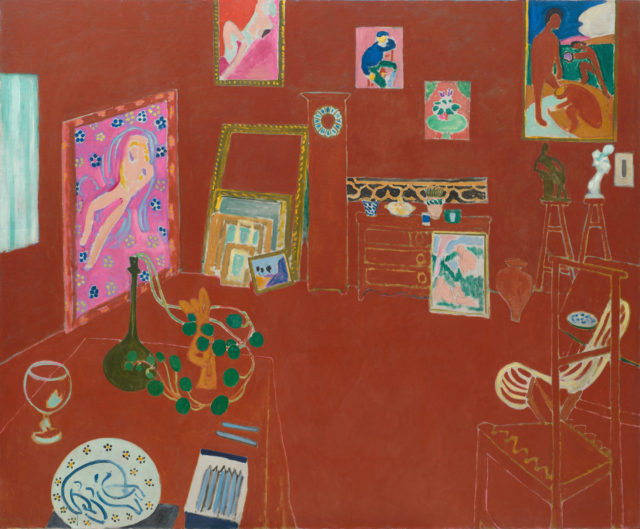
Henri Matisse, The Red Studio, oil on canvas, fall 1911 (Mrs. Simon Guggenheim Fund; © 2022 Succession H. Matisse / Artists Rights Society [ARS], New York)
MATISSE: THE RED STUDIO
MoMA, Museum of Modern Art
11 West 53rd St. between Fifth & Sixth Aves.
Through September 10, $14-$25 (sixteen and under free)
212-708-9400
www.moma.org
“It’s always been sort of a very mysterious painting,” MoMA senior paintings conservator Anny Aviram says in a short video (see below) about Henri Matisse’s The Red Studio. “He leaves clues, but at the same time he confuses you.” The 1911 masterpiece, a painting of the artist’s studio in the Parisian suburb of Issy-les-Moulineaux that includes miniature versions of other works and objects, is explored in extraordinary detail in “Matisse: The Red Studio,” on view at MoMA through September 10.
The exhibition is divided into two parts; one looks at the history behind the creation and presentation of the work, while the other gathers all the extant pieces that are depicted on the canvas. Thus, on one side, you’ll find detailed information about the construction of the studio itself; correspondence between Matisse and collector Sergei Shchukin, who is also seen in a charcoal sketch; photographs of Matisse and his family; a letter from David Tennant and Harry Rowan Walker to Matisse confirming their purchase of the painting for £806 for the Gargoyle Club; Roger Fry’s A Room at the Second Post-Impressionist Exhibition, in which a significant portion of The Red Studio can be seen on the back wall; Matisse’s lovely, claustrophobic The Studio under the Eaves; the marvelous The Studio, quai Saint-Michel, another interior with dramatic lines and canvases that mimic windows; and other ephemera.
In the other room, The Red Studio is surrounded by eleven of the works that appear in it, from paintings, sculpture, and a ceramic plate to drawings of one canvas that has been lost, in addition to tables, chairs, flowers, and design elements that can be found in works in the previous room. The painting wasn’t originally all Venetian red; as the above video reveals, tiny bits of the original colors are still visible, along with a few stray paintbrush bristles. Among the works are the bold sculpture Jeannette IV, the daring Nude with a White Scarf, the entrancing Le luxe (II), the intriguing Young Sailor II, and the rare Impressionistic landscape Corsica, the Old Mill. This is the first time the works have been together since they were in the studio when Matisse painted them, and the reunion is utterly thrilling.
Be sure to listen to the audioguide, which features commentary from curator Ann Temkin along with artists Faith Ringgold and Lisa Yuskavage, writers Siri Hustvedt and Claire Messud, and professor Mehammed Mack. “What we really wanted to do was bring visitors into Matisse’s world, first of all, into the studio that’s the subject of the painting, into the other artworks that are in the painting, and then into the events and artworks that relate to this work as it went on to live its life in the decades following its making,” Temkin explains. “The outrage caused by these images, their radicality when they were produced, is something that I think is good to recover,” Hustvedt explains. “That deconstruction of color, like disassociating color from the object, is a kind of revolutionary act,” Mack adds. “Matisse is so easy to think about as the maker of beautiful, relaxing pictures. We really wanted to try to re-create what extraordinary focus and effort and leaps of imagination and daring an artist goes through in making a work of radical innovation, like The Red Studio,” Temkin continues. “That, for me, is the fascination. It’s as if we have a glimpse inside his head,” Messud concludes. It’s quite a journey.